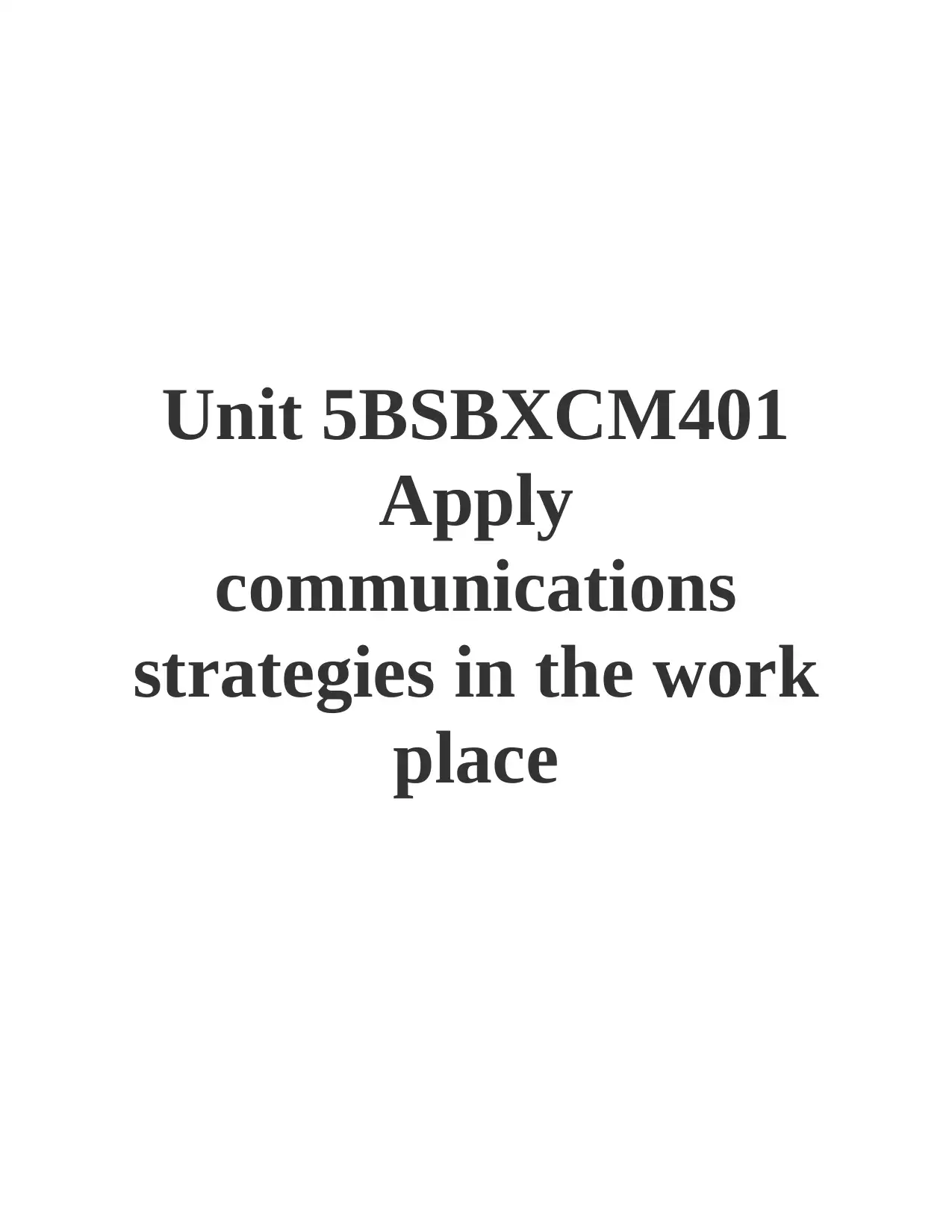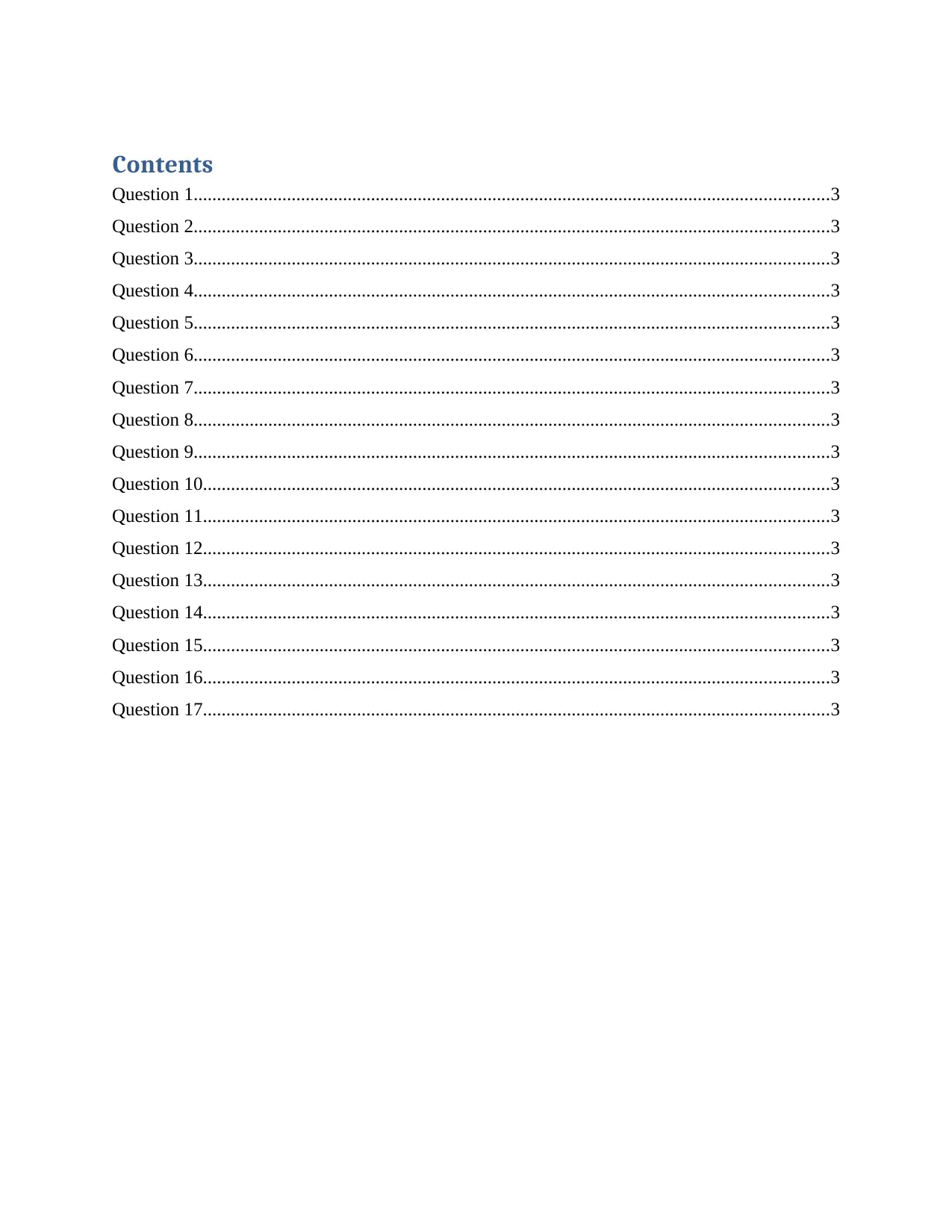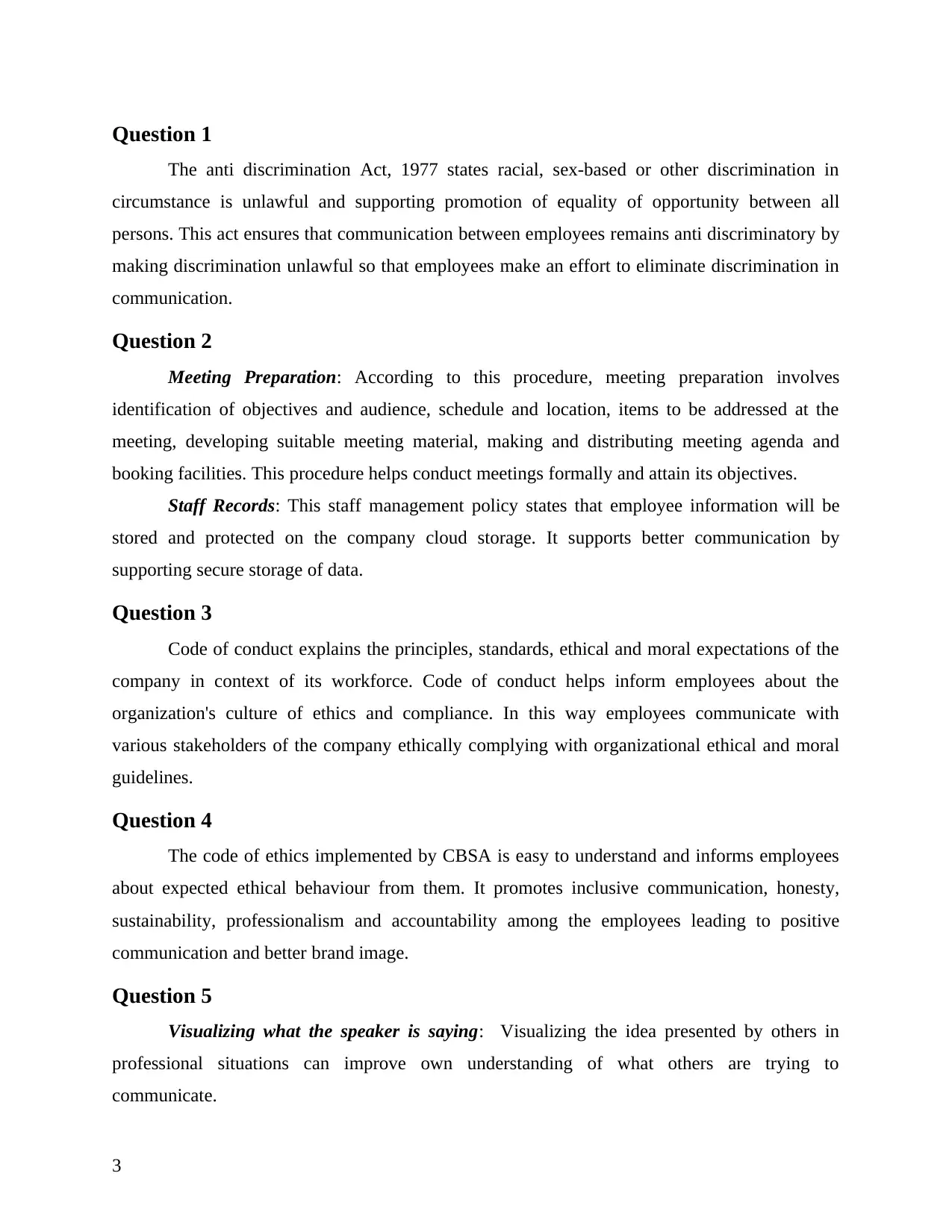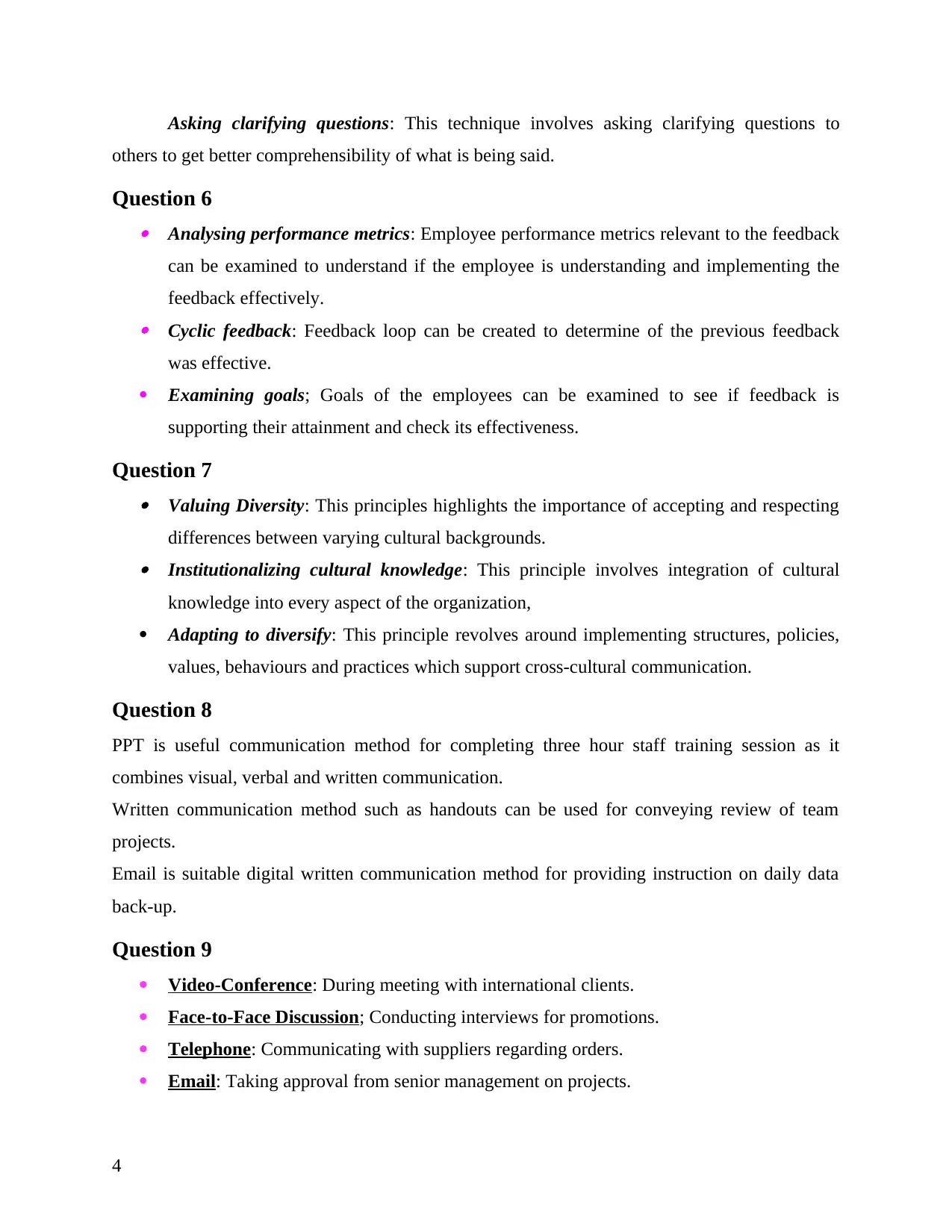Apply Communication Strategies in Workplace: BSBXCM401 Assignment
VerifiedAdded on 2023/06/08
|7
|1356
|270
Homework Assignment
AI Summary
This document presents solutions to a BSBXCM401 assignment focusing on applying communication strategies in the workplace. The assignment covers various aspects of effective communication, including legal frameworks like the Anti-Discrimination Act and the Fair Work Act. It explores meeting preparation, staff records, codes of conduct and ethics, and techniques for improving communication, such as active listening and asking clarifying questions. The document also addresses different communication styles (passive, aggressive, assertive), and the application of verbal, non-verbal, and written communication. It analyzes a case study involving conflict resolution between employees, emphasizing the importance of ethical behavior, grievance procedures, and the impact of conflict on team performance. The solutions also provide insights into the use of different communication methods like PPT, email, and video conferencing and the potential risks associated with them.

Unit 5BSBXCM401
Apply
communications
strategies in the work
place
Apply
communications
strategies in the work
place
Paraphrase This Document
Need a fresh take? Get an instant paraphrase of this document with our AI Paraphraser

Contents
Question 1........................................................................................................................................3
Question 2........................................................................................................................................3
Question 3........................................................................................................................................3
Question 4........................................................................................................................................3
Question 5........................................................................................................................................3
Question 6........................................................................................................................................3
Question 7........................................................................................................................................3
Question 8........................................................................................................................................3
Question 9........................................................................................................................................3
Question 10......................................................................................................................................3
Question 11......................................................................................................................................3
Question 12......................................................................................................................................3
Question 13......................................................................................................................................3
Question 14......................................................................................................................................3
Question 15......................................................................................................................................3
Question 16......................................................................................................................................3
Question 17......................................................................................................................................3
Question 1........................................................................................................................................3
Question 2........................................................................................................................................3
Question 3........................................................................................................................................3
Question 4........................................................................................................................................3
Question 5........................................................................................................................................3
Question 6........................................................................................................................................3
Question 7........................................................................................................................................3
Question 8........................................................................................................................................3
Question 9........................................................................................................................................3
Question 10......................................................................................................................................3
Question 11......................................................................................................................................3
Question 12......................................................................................................................................3
Question 13......................................................................................................................................3
Question 14......................................................................................................................................3
Question 15......................................................................................................................................3
Question 16......................................................................................................................................3
Question 17......................................................................................................................................3

Question 1
The anti discrimination Act, 1977 states racial, sex-based or other discrimination in
circumstance is unlawful and supporting promotion of equality of opportunity between all
persons. This act ensures that communication between employees remains anti discriminatory by
making discrimination unlawful so that employees make an effort to eliminate discrimination in
communication.
Question 2
Meeting Preparation: According to this procedure, meeting preparation involves
identification of objectives and audience, schedule and location, items to be addressed at the
meeting, developing suitable meeting material, making and distributing meeting agenda and
booking facilities. This procedure helps conduct meetings formally and attain its objectives.
Staff Records: This staff management policy states that employee information will be
stored and protected on the company cloud storage. It supports better communication by
supporting secure storage of data.
Question 3
Code of conduct explains the principles, standards, ethical and moral expectations of the
company in context of its workforce. Code of conduct helps inform employees about the
organization's culture of ethics and compliance. In this way employees communicate with
various stakeholders of the company ethically complying with organizational ethical and moral
guidelines.
Question 4
The code of ethics implemented by CBSA is easy to understand and informs employees
about expected ethical behaviour from them. It promotes inclusive communication, honesty,
sustainability, professionalism and accountability among the employees leading to positive
communication and better brand image.
Question 5
Visualizing what the speaker is saying: Visualizing the idea presented by others in
professional situations can improve own understanding of what others are trying to
communicate.
3
The anti discrimination Act, 1977 states racial, sex-based or other discrimination in
circumstance is unlawful and supporting promotion of equality of opportunity between all
persons. This act ensures that communication between employees remains anti discriminatory by
making discrimination unlawful so that employees make an effort to eliminate discrimination in
communication.
Question 2
Meeting Preparation: According to this procedure, meeting preparation involves
identification of objectives and audience, schedule and location, items to be addressed at the
meeting, developing suitable meeting material, making and distributing meeting agenda and
booking facilities. This procedure helps conduct meetings formally and attain its objectives.
Staff Records: This staff management policy states that employee information will be
stored and protected on the company cloud storage. It supports better communication by
supporting secure storage of data.
Question 3
Code of conduct explains the principles, standards, ethical and moral expectations of the
company in context of its workforce. Code of conduct helps inform employees about the
organization's culture of ethics and compliance. In this way employees communicate with
various stakeholders of the company ethically complying with organizational ethical and moral
guidelines.
Question 4
The code of ethics implemented by CBSA is easy to understand and informs employees
about expected ethical behaviour from them. It promotes inclusive communication, honesty,
sustainability, professionalism and accountability among the employees leading to positive
communication and better brand image.
Question 5
Visualizing what the speaker is saying: Visualizing the idea presented by others in
professional situations can improve own understanding of what others are trying to
communicate.
3
⊘ This is a preview!⊘
Do you want full access?
Subscribe today to unlock all pages.

Trusted by 1+ million students worldwide

Asking clarifying questions: This technique involves asking clarifying questions to
others to get better comprehensibility of what is being said.
Question 6 Analysing performance metrics: Employee performance metrics relevant to the feedback
can be examined to understand if the employee is understanding and implementing the
feedback effectively. Cyclic feedback: Feedback loop can be created to determine of the previous feedback
was effective.
Examining goals; Goals of the employees can be examined to see if feedback is
supporting their attainment and check its effectiveness.
Question 7 Valuing Diversity: This principles highlights the importance of accepting and respecting
differences between varying cultural backgrounds. Institutionalizing cultural knowledge: This principle involves integration of cultural
knowledge into every aspect of the organization,
Adapting to diversify: This principle revolves around implementing structures, policies,
values, behaviours and practices which support cross-cultural communication.
Question 8
PPT is useful communication method for completing three hour staff training session as it
combines visual, verbal and written communication.
Written communication method such as handouts can be used for conveying review of team
projects.
Email is suitable digital written communication method for providing instruction on daily data
back-up.
Question 9
Video-Conference: During meeting with international clients.
Face-to-Face Discussion; Conducting interviews for promotions.
Telephone: Communicating with suppliers regarding orders.
Email: Taking approval from senior management on projects.
4
others to get better comprehensibility of what is being said.
Question 6 Analysing performance metrics: Employee performance metrics relevant to the feedback
can be examined to understand if the employee is understanding and implementing the
feedback effectively. Cyclic feedback: Feedback loop can be created to determine of the previous feedback
was effective.
Examining goals; Goals of the employees can be examined to see if feedback is
supporting their attainment and check its effectiveness.
Question 7 Valuing Diversity: This principles highlights the importance of accepting and respecting
differences between varying cultural backgrounds. Institutionalizing cultural knowledge: This principle involves integration of cultural
knowledge into every aspect of the organization,
Adapting to diversify: This principle revolves around implementing structures, policies,
values, behaviours and practices which support cross-cultural communication.
Question 8
PPT is useful communication method for completing three hour staff training session as it
combines visual, verbal and written communication.
Written communication method such as handouts can be used for conveying review of team
projects.
Email is suitable digital written communication method for providing instruction on daily data
back-up.
Question 9
Video-Conference: During meeting with international clients.
Face-to-Face Discussion; Conducting interviews for promotions.
Telephone: Communicating with suppliers regarding orders.
Email: Taking approval from senior management on projects.
4
Paraphrase This Document
Need a fresh take? Get an instant paraphrase of this document with our AI Paraphraser

SMS: Talking with employees on remote working.
Facebook: Communicating with public, recruitment candidates or target consumers.
Question 10
The main features of passive communication style are being apologetic, self-
deprecating, incessant permission asking, poor confidence, anxious behaviour, lack of eye
contact, poor body language, poor body posture and extreme sensitivity.
Aggressive communication style is characterized by being commanding, demanding,
condescending, verbally abusive, expressive, opinionated, maintaining intense eye contact,
dominating body language, high tone of voice, blaming others and making offensive comments.
The characteristics of assertive communication style are assertive posture, direct eye
contact, high level of clarity, positive language, non-threatening language and right timing.
Question 11
Characteristics of :- Verbal Communication: Usage of concepts to communicate, direct or indirect relation to
subject during communication and usage of voice as the essential medium of verbal
communication. Non-Verbal Communication: Informality, usage of eye-contact, gestures, facial
expression, body movement, and touch, paying attention to space and inconsistencies.
Written Communication: Usage of spelling and grammar, high level of clarity,
importance of composition, high level of formality and inclusion of relevant details.
Question 12
Practising listening; This technique can be used for reducing miscommunication because
of cultural difference and improving cross-cultural communication.
Increasing cultural sensitivity; Higher cultural sensitivity helps improve cross-cultural
communication. This is because it makes employees respectful of individuals from different
cultural backgrounds.
Improving emotional intelligence: Good Emotional Intelligence helps individuals
understand meaning of gestures and emotional cues lost because of cultural differences.
5
Facebook: Communicating with public, recruitment candidates or target consumers.
Question 10
The main features of passive communication style are being apologetic, self-
deprecating, incessant permission asking, poor confidence, anxious behaviour, lack of eye
contact, poor body language, poor body posture and extreme sensitivity.
Aggressive communication style is characterized by being commanding, demanding,
condescending, verbally abusive, expressive, opinionated, maintaining intense eye contact,
dominating body language, high tone of voice, blaming others and making offensive comments.
The characteristics of assertive communication style are assertive posture, direct eye
contact, high level of clarity, positive language, non-threatening language and right timing.
Question 11
Characteristics of :- Verbal Communication: Usage of concepts to communicate, direct or indirect relation to
subject during communication and usage of voice as the essential medium of verbal
communication. Non-Verbal Communication: Informality, usage of eye-contact, gestures, facial
expression, body movement, and touch, paying attention to space and inconsistencies.
Written Communication: Usage of spelling and grammar, high level of clarity,
importance of composition, high level of formality and inclusion of relevant details.
Question 12
Practising listening; This technique can be used for reducing miscommunication because
of cultural difference and improving cross-cultural communication.
Increasing cultural sensitivity; Higher cultural sensitivity helps improve cross-cultural
communication. This is because it makes employees respectful of individuals from different
cultural backgrounds.
Improving emotional intelligence: Good Emotional Intelligence helps individuals
understand meaning of gestures and emotional cues lost because of cultural differences.
5

Question 13
The conflicts between Sue and Jane will have significant negative impact on the
functioning of the team. It will create challenges in completing team meetings effectively as two
employees are refusing to interact and collaborate with each. Other. There will also be challenges
in implementing activities as the team will not be able to reach maximum synergy. The conflict
between Jane and Sue has escalated to level of name calling which may create negative
environment in the team. It can also lead to formation of groups supporting Jane and Sue in the
conflict resulting in reduced team efficiency.
Question 14
The behaviour displayed by Jane and Sue did not comply with CBSA code of ethics and
both of them did not maintain their integrity and professionalism. Sue not following Jane's plan
disobeyed CBSA code of ethics about accountability and honesty. Jane also behaved
unprofessionally by engaging in mean spirited name calling.
Question 15
The conflict will be resolved by officially carrying out employee grievance procedure for
the issue of conflict between Jane and Sue. This will involve the steps of acknowledging
employee grievance, conducting formal investigation, writing conclusion and calling mediator
and taking action on the basis of agreement reached or recommendation provided. In this way
the employees will be able to resolve the issue formally without any further conflict affecting
team performance. Both the employees and other parties involved in the conflict will get
opportunity to represent their side of the story and get the best results. The grievance procedure
will be documented to record the process of resolving conflict.
Question 16
The Fair Work Act, 2010 applies to the case study of Jane and Sue because it introduces a
national workplace relations system and legal framework for employee employer relations. It's
important to establish effective employee communication. Employee disputes can be resolved
through mediation and negotiation under the fair work act.
6
The conflicts between Sue and Jane will have significant negative impact on the
functioning of the team. It will create challenges in completing team meetings effectively as two
employees are refusing to interact and collaborate with each. Other. There will also be challenges
in implementing activities as the team will not be able to reach maximum synergy. The conflict
between Jane and Sue has escalated to level of name calling which may create negative
environment in the team. It can also lead to formation of groups supporting Jane and Sue in the
conflict resulting in reduced team efficiency.
Question 14
The behaviour displayed by Jane and Sue did not comply with CBSA code of ethics and
both of them did not maintain their integrity and professionalism. Sue not following Jane's plan
disobeyed CBSA code of ethics about accountability and honesty. Jane also behaved
unprofessionally by engaging in mean spirited name calling.
Question 15
The conflict will be resolved by officially carrying out employee grievance procedure for
the issue of conflict between Jane and Sue. This will involve the steps of acknowledging
employee grievance, conducting formal investigation, writing conclusion and calling mediator
and taking action on the basis of agreement reached or recommendation provided. In this way
the employees will be able to resolve the issue formally without any further conflict affecting
team performance. Both the employees and other parties involved in the conflict will get
opportunity to represent their side of the story and get the best results. The grievance procedure
will be documented to record the process of resolving conflict.
Question 16
The Fair Work Act, 2010 applies to the case study of Jane and Sue because it introduces a
national workplace relations system and legal framework for employee employer relations. It's
important to establish effective employee communication. Employee disputes can be resolved
through mediation and negotiation under the fair work act.
6
⊘ This is a preview!⊘
Do you want full access?
Subscribe today to unlock all pages.

Trusted by 1+ million students worldwide

Question 17
Potential Risk: There is risk of electrical accident as employees will be using various
electrical equipment which are not wireless. This can lead to electrical hazard such as electrical
fire due to mismanagement of electrical products.
Challenges when delivering video presentation: Technical difficulties are the primary
challenge affecting delivery of PPT presentation including projector or laptop stoppage. Failing
to address employee concern and engaging them emotionally to reduce boredom are some other
challenges associated with delivering PPT presentation to employees. There is also barrier of
using too much technical terminology resulting in lack of understanding of employees.
7
Potential Risk: There is risk of electrical accident as employees will be using various
electrical equipment which are not wireless. This can lead to electrical hazard such as electrical
fire due to mismanagement of electrical products.
Challenges when delivering video presentation: Technical difficulties are the primary
challenge affecting delivery of PPT presentation including projector or laptop stoppage. Failing
to address employee concern and engaging them emotionally to reduce boredom are some other
challenges associated with delivering PPT presentation to employees. There is also barrier of
using too much technical terminology resulting in lack of understanding of employees.
7
1 out of 7
Related Documents
Your All-in-One AI-Powered Toolkit for Academic Success.
+13062052269
info@desklib.com
Available 24*7 on WhatsApp / Email
![[object Object]](/_next/static/media/star-bottom.7253800d.svg)
Unlock your academic potential
Copyright © 2020–2025 A2Z Services. All Rights Reserved. Developed and managed by ZUCOL.





